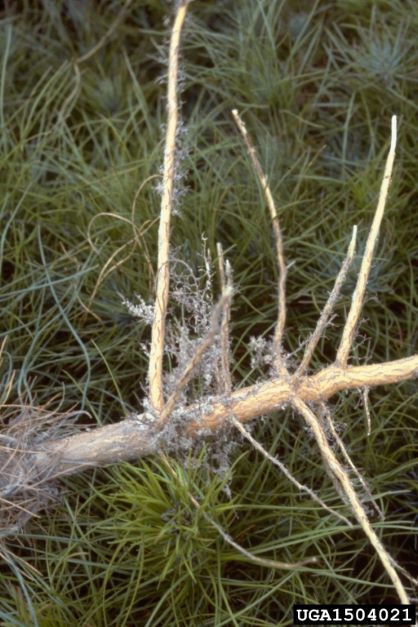Beneficial Fungi and Tree Health

Tree health is often a reflection root health. Good practices to improve root health include properly applied organic mulch, good water management to avoid overwatering but providing water as needed during dry periods, and avoiding root damage from construction or changes in soil grade. The Image shows thin white fungal mycorrhizae on the roots of a slash pine by Paul A. Mistretta, USDAForest Service, Bugwood.org
Another major contributor to tree health, often unseen and unknown to gardeners, are a vast array of beneficial soil fungi working in harmony with trees to create a win-win situation for both organisms. These beneficial organisms are called mycorrhizal fungi, which comes from Greek “myco” fungus and “rhizae” root, translating to fungus roots. (plural - micorrhizae)
Have you ever raked back mulch beneath a tree and found a spider’s web of slender white branching “hairs” covering the soil surface? Those were fungal roots, most likely from mycorrhizal fungi.
What Are Mycorrhizal Fungi?
There are many species of naturally occurring micorrhizae. When a tree is planted fungal roots grow toward, attach themselves to and enter the tree’s roots. This connection essentially makes them an extension of the tree’s root system. Mycorrhizal fungi collect water and nutrients from the soil and pass them to the tree. In exchange, the tree gives the fungi food, in the form of carbohydrates the tree has manufactured through photosynthesis.
The natural state of trees is to be “infected” with mycorrhizal fungi and a tree often has several different species of fungi associated with its root system. Two types of fungi commonly associated with trees are ectomycorrhizae (EM) and arbuscular mycorrhizae (AM, also syn. endomycorrhizae).
EM grow into a tree’s root by pushing between the outer cortical cells. They can also form a thick outer layer on tree root hairs, which is visible to the naked eye. Each EM fungal species tends to form an association with a specific tree species. Tree species colonized by EM include fir, hemlock, pine, fir, spruce, alder, aspen, beech, birch, hickory, linden, oak and poplar. These fungi reproduce through spores produce on mushrooms and puffballs, which can easily move through the air and recolonize disturbed soil.
AM fungal roots enter into tree root cells and are so small they cannot be seen without a microscope. In contrast to EM, AM fungal species are generalists and can associate with hundreds of host species. Tree species colonized by AM include apple, arborvitae, ash, buckeye, catalpa, cedar, cherry, cypress, dogwood, elm, gingko, hawthorn, juniper, magnolia, maple, redbud, redwood, maple, serviceberry, sycamore, sweetgum, tulip tree, viburnum and walnut. They reproduce through soil-borne spores, which are not spread as easily through the wind as EM. Tree species highly dependent on these fungi can exhibit slower growth when planted on disturbed soil if low quantities of fungi are present.
How do Mycorrhizal Fungi Benefit Trees?
Water and nutrient uptake. How much can fungal mycelium expand the total reach of a tree’s root system? Estimates range from five times the normal spread of a root system and up. This results in increased water and nutrients available to the tree for growth, defense or storage at a reduced energy “cost” in terms of the amount of carbohydrates the tree has expended to access those resources.
Pest and disease resistance. Some mycorrhizal fungi can outcompete other harmful fungi and act as armor around fragile roots protecting them from infection. Others produce antibiotic compounds to protect roots from soil pathogens.
Survival on harsh sites. Some fungi help trees tolerate difficult sites with high or low pH, high salt, low fertility or contain heavy metals. Exactly how mycorrhizal fungi do this is not yet well understood, but much of the benefit comes from increased water and nutrient uptake.
Encouraging Mycorrhizae in Your Soil
Many of the practices used to create good tree growth, also encourage fungi growth.
- Use landscape fungicides carefully. Foliage sprays of fungicide don’t have a high impact on soil fungi, but avoid soil drench applications of systemic fungicides. These can stop the growth of beneficial fungi, as well as the bad guys.
- Limit fertilization. High soil fertilization actually reduces fungi growth. Avoid large applications of fertilizer, especially those high in nitrogen and phosphorus.
- Maintain native fungi populations. Tilling, removing plant litter and debris, heavy fertilizer applications and the use of systemic soil drench fungicides all reduce natural fungus growth.
- Maintain even soil moisture. Fungal mycelium dry out and die if soil conditions get very dry during periods of drought. Applying water to maintain the tree’s health will also encourage continued functioning from mycorrhizal fungi.
- Apply mulch beneath trees. Fungal mycelium grow better under organic mulch (wood chips, bark chips, pine straw, etc.) than in turfgrasses.
Is it worthwhile applying mycorrhizal fungal innoculants from your local nursery to plants in your landscape? Research hasn’t provided clear answers yet, but is ongoing. Applying them won’t hurt plants, but for now the benefits of these products compared to their cost suggests just using good tree care and management practices provides a more reliable benefit to help both the tree and native fungi grow best.
For more information on tree care, visit How To Care For Trees from the Nebraska Forest Service.
This article was reviewed by Kelly Feehan
Sign up for updates from UNL Water
